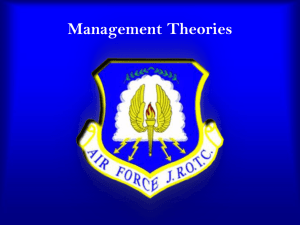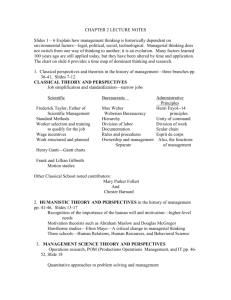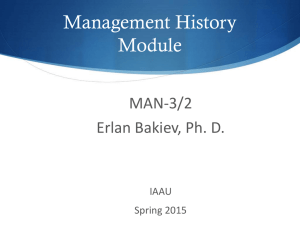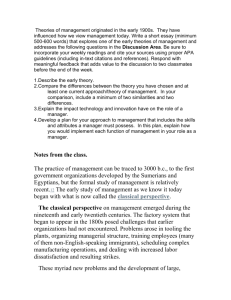Process and Perspectives of Organizational Communication
advertisement
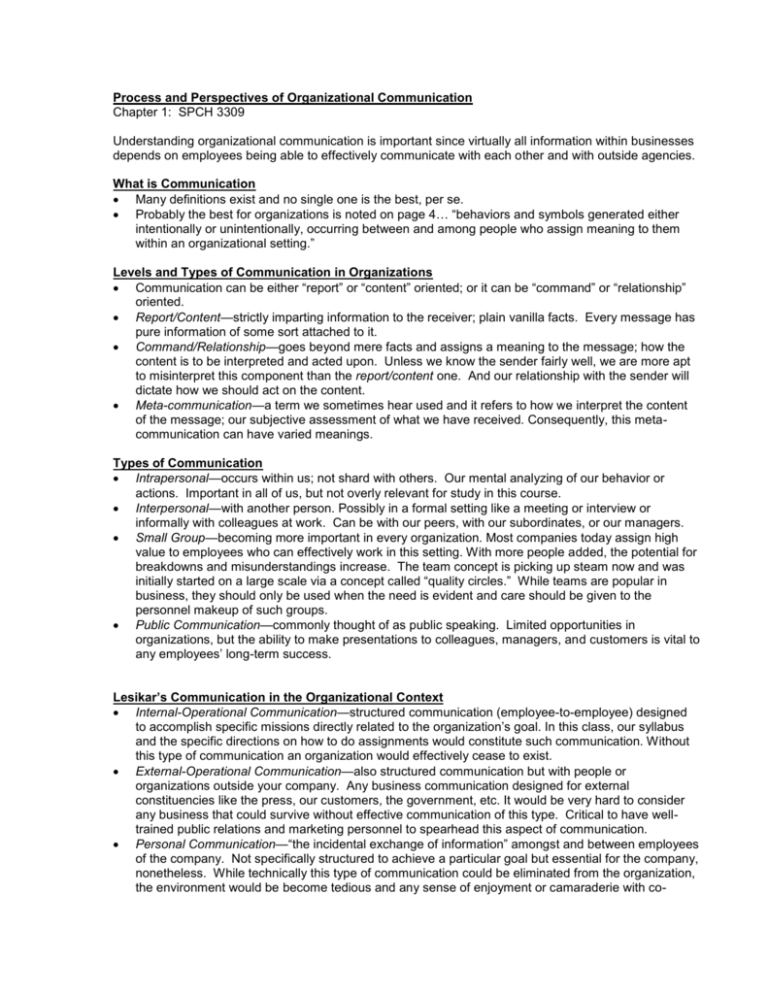
Process and Perspectives of Organizational Communication Chapter 1: SPCH 3309 Understanding organizational communication is important since virtually all information within businesses depends on employees being able to effectively communicate with each other and with outside agencies. What is Communication Many definitions exist and no single one is the best, per se. Probably the best for organizations is noted on page 4… “behaviors and symbols generated either intentionally or unintentionally, occurring between and among people who assign meaning to them within an organizational setting.” Levels and Types of Communication in Organizations Communication can be either “report” or “content” oriented; or it can be “command” or “relationship” oriented. Report/Content—strictly imparting information to the receiver; plain vanilla facts. Every message has pure information of some sort attached to it. Command/Relationship—goes beyond mere facts and assigns a meaning to the message; how the content is to be interpreted and acted upon. Unless we know the sender fairly well, we are more apt to misinterpret this component than the report/content one. And our relationship with the sender will dictate how we should act on the content. Meta-communication—a term we sometimes hear used and it refers to how we interpret the content of the message; our subjective assessment of what we have received. Consequently, this metacommunication can have varied meanings. Types of Communication Intrapersonal—occurs within us; not shard with others. Our mental analyzing of our behavior or actions. Important in all of us, but not overly relevant for study in this course. Interpersonal—with another person. Possibly in a formal setting like a meeting or interview or informally with colleagues at work. Can be with our peers, with our subordinates, or our managers. Small Group—becoming more important in every organization. Most companies today assign high value to employees who can effectively work in this setting. With more people added, the potential for breakdowns and misunderstandings increase. The team concept is picking up steam now and was initially started on a large scale via a concept called “quality circles.” While teams are popular in business, they should only be used when the need is evident and care should be given to the personnel makeup of such groups. Public Communication—commonly thought of as public speaking. Limited opportunities in organizations, but the ability to make presentations to colleagues, managers, and customers is vital to any employees’ long-term success. Lesikar’s Communication in the Organizational Context Internal-Operational Communication—structured communication (employee-to-employee) designed to accomplish specific missions directly related to the organization’s goal. In this class, our syllabus and the specific directions on how to do assignments would constitute such communication. Without this type of communication an organization would effectively cease to exist. External-Operational Communication—also structured communication but with people or organizations outside your company. Any business communication designed for external constituencies like the press, our customers, the government, etc. It would be very hard to consider any business that could survive without effective communication of this type. Critical to have welltrained public relations and marketing personnel to spearhead this aspect of communication. Personal Communication—“the incidental exchange of information” amongst and between employees of the company. Not specifically structured to achieve a particular goal but essential for the company, nonetheless. While technically this type of communication could be eliminated from the organization, the environment would be become tedious and any sense of enjoyment or camaraderie with co- workers would dissolve. In short, we need to be able to chat with our co-workers about work and other items to make us more effective employees. Models of Communication 1. Communication as Action (Shannon & Weaver) The first real communication model developed by engineers. Helpful in that is breaks the communication process into specific parts and identifies each and the role they play. But it is limited in that it failed to recognize the complexity and the subtly of the communication process. In short, it is a good “first step” in understanding communication but does not go far enough to fully grasp all the elements that are at work. It’s three basic assumptions are: (a) communication is a linear process; (b) each element in the model is impacted only by the one next to it in a proximity sense; and (c) communication can be studied and understand by parts and those parts add up to the whole; nothing more. (page 9-10) 2. Communication as Interaction (Circular). This model builds on the Shannon & Weaver depiction by adding certain factors to the process. Feedback and noise are now introduced to the communication process. Certainly a more comprehensive and accurate depiction of communication but still not fully complete. It suggests that communication consists of “discrete acts” of sending and receiving. And while this might seem logical on the surface, in reality communication often does not wait for one “discrete act” to finish before another act is underway. In short, communication is not as tidy and neatly tucked away as this implies. (page 10-11) 2. Communication as Transaction (the Contemporary model). No longer was communication seen as linear (Shannon & Weaver) or as circular, but rather as simultaneous and continuous (transactional). The sender and receiver might be communicating at the same time. As a result, the terms sender and receiver seemed passé and became simply referred to as “communicators.” It is much like the second model but has added this important element of the transactional process which adds the final piece to this mosaic. (page 11-13) Barriers to Organizational Communication The Process of Abstracting— As we move up or down the Abstraction Ladder (p. 13-14) we lose or gain perspective, depending on where we are on that ladder. Each step up or down moves us away from something and thus, it becomes more abstract to us. There is a tendency for us to get comfortable at some level on that ladder (like an organizational hierarchy chart) and not want to move. People who only can see an organizational from one particular rung on the ladder fall victim to this barrier. We need to see the organization from different perspectives (levels on the ladder). As we to less abstract levels we can see the issues more clearly and with less distortion. For example, it is hard for any employee (management or labor) to fully grasp the perspective of the other when they only see the organization from their point of view or level of abstraction. For this barrier to be lifted, we need to move up and down and ladder to gain added perspective from views other than our own. Physical Separation— The obvious problem of keeping open and constructive communication when you are not present is difficult, at best. Those working in distance offices or at home face this problem. We often feel disaffected and detached by the workings of the home office. Loyalty is a problem and commitment to the overall corporate goals is a greater challenge. This is somewhat of a double-edged sword since there are advantages to “home-based” work as well as these limitations. Power and Status Differences— Traditionally those of different power and status within an organization do not communicate well with each other, if at all. The more we perceive we are different from others, the less we communicate with them. It takes strong leadership from the top and passed on down to lower-level managers not to make the inherent differences in power and status become a major corporate communication problem. Job Specialization— The more specialized people become with their jobs, the more they are likely to keep their communication confined with other “like” workers. We often see others as not understanding or not appreciating what we do. As a result, we often stay with or communicate only with “our kind”; those appreciate and understand our contributions. We do this in our personal lives with our friends, so it’s not surprising this can happen at work as well. “Information Ownership”— Information is power and sharing that power can weaken your value or position in an organization, That way of thinking creates a barrier. It is self-serving and counter to organizational values, but it is human and it will present problems in any company faced with this dilemma. Again, top leadership is responsible for establishing in a corporate culture in which the hoarding of information is not rewarded and the sharing of it is! Implications of Abstracting and Barriers— Since no two people or things are exactly alike, there are (in theory) an infinite number of possible interpretations to events. While this is not often a major communication problem, the more people, the more events, the greater the differences between those communicating all add up to an increased likelihood of communication breakdowns. “Mechanisms of Rigidity” contribute to the problem. It refers to the tendency to stabilize the image of other people in our mind even though time may have caused them (and us) to change dramatically. It is easy to see things as they “were” rather than as they “are” at the present. Additionally, this concept adds that we are likely to always hold this view; assuming that people do not change from what we remember. This static image of people is seldom accurate. This might be true in some instances but often people do change and what we are today is not what were 5, 10, 20 years ago. Communication based on perceptions of reality. Since human perception is limited, we can only communicate about a very small part of the reality we perceive. Much goes unnoticed since it is not part of our reality. As we draw perceptions about others we do so on the basis of their attitudes and other personal characteristics along with situational factors like time and location. In other words, what we perceive about others is based on their personality traits as well as how those traits are affected by when they occur and where they occur. We often err by assuming that people act the same way all the time. Our personalities vary by time and location. But if fail to recognize this, we fall prey to what is referred to as “overestimating personal unity.” This happens when we forgot that the roles we play change depending on the time and the location. In short, no one behaves the same way in all situations all the time. Related to this perception difficulty is Ichheiser’s “mote beam mechanism” which refers to the notion that we may perceive certain characteristics in others that we do not see in ourselves. In sum, we can only perceive a small percentage of reality. And we often perceive characteristics in others that we cannot perceive in ourselves. Imprecise relationship between words and reality. The words we choose to describe reality will be imprecise and inexact. It is impossible for us to find just the right words to describe true reality. Others will always interpret it slightly different from what we intended or we will choose slightly the wrong of communicating it. In short, we must understand that words can be misunderstood easily no matter how careful we are in choosing them. Uniqueness of Meanings and Perceptions. Because we are all unique individuals our life experiences are difference as well. Our frames of references, albeit similar to others, will be different as well. These perceptual filters will cause us to see events and people slightly different from some while significantly different from others. And if we have had no shared experiences with others, it becomes increasingly difficult to communicate effectively. There will always be some degree of communication breakdown…that is human. Our mission is to keep that degree of breakdown to a minimum. Classical Management Theories Overall goal was to resolve tensions between organization and individual needs by introducing efficient operating procedures, eliminating arbitrary supervisor behavior, and motivating workers through economic incentives. Its roots go back to the Industrial Revolution of the late 18 th and early 19th century. Classical theorists focused on the importance of structure and administrative control of performance. Great emphasis on organizational rules with little attention paid to the value of the individual. There are sub-divisions that fall under this large umbrella…the key ones are: Scientific Management—key name is Frederick Taylor; concerned with the sloppy, haphazard, and unsystematic operation of businesses. Taylor felt managers needed to be better trained; often they were unnecessarily wasteful and inept. In short, he believed managers were at least as responsible for the success or failure of the organization. His “time and motion” studies broke down tasks to detailed steps that could be performed efficiently. The key principles that emerged from his work were (1) workers were primarily motivated by money and economic rewards; (2) workers needed to be developed to their maximum potential; (3) pay workers on their performance; not by the hour; (4) the need for cooperation among workers and between management and workers; and (5) organization and individual goals can be compatible. Where he erred….he assumed as organizations grew, all employees would share as the “pie” got larger for all. But that did not happen, as often management kept larger portions of the “pie.” His goals were honorable but others corrupted and abused the principles by taking advantage of the worker. Gave rise to need for strong unions. Fayol’s Principles of Management—focus was on the administrative side of management and developing clear structure and order in complex organizations. His major principles were: (1) Division of labor; workers needed to know their specific responsibilities and who was to do what. (2) Discipline; subordinates were to follow the orders of their superiors and managers were ultimately responsible for the work completed. (3) Unity of command; or the chain-of-command concept; to be honored in all but extreme instances. (4) Organizational hierarchy or schematic depicting who reports to whom. His “bridge” concept which circumvented this hierarchy was to be used only sparingly. (5) Esprit de corps; meaning that the organization needed to communicate the mission and goals to all workers. Face-to-face communication was important to him; not common amongst classical theorists. He was similar to Taylor but probably showed slightly more attention to the workers and their involvement in the organization. Yet he also strongly supported allegiance to the corporation. Weber’s Theory of Bureaucracy—he recognized the relationship between organizations and the culture they exist in. The economic, political, religious, etc elements of any culture. Weber , the Father of Bureaucracy, strongly believed in a written code of rules to follow; they provide order and protect workers from abusive managers. In essence, his beliefs centered on formalized rules, procedures, and regulations that exist within a clearly defined corporate hierarchy. He felt managers needed to keep a professional distance from workers to avoid charges of bias or unfair control. Such bureaucracy is not without criticisms of too much “red tape” and the stifling of creative thinking. Yet it still offers benefits to companies in clear guidelines, provide predictability and stability and structure. But it still limits effectiveness in situations that require creativity and flexibility in decision-making. We need it to some degree in all organizations, but how much of it is the critical question. All three of these management perspectives have been referred to as the classical management perspective. And in general, they all promote the ideas of standardization, organization, strict policies and procedures, job descriptions regulations, formal flow of communication, and social control. The belief was that workers were motivated strictly by money. Communication played a role only in for the form of providing instruction or training for workers. It worked almost exclusively in a downward direction and there existed little, to any, social interaction between bosses and workers. In today’ workplace such rules and concepts are seldom practiced. The evolution of technology and other factors have transformed the business environment into a fast-paced and often unpredictable world in which companies must adapt quickly. Old “smoke-stack” industries in the days of Taylor, Fayol, and Weber are largely dinosaurs today. After the Classical theories of communication behavior, other more modern perspectives began to emerge. Human Relations Theory Seen as somewhat of a reaction of the basic principles of the Classical theorists, though not a complete rejection of the core values. Suddenly, relationships and social interaction between bosses and workers became important. Traditional values like organization hierarchy and managerial authority were still prevalent, but managers were expected to show more concern for the individual as well. This theory found its roots almost by accident via the experiments done at what become known the Hawthorne Studies spearheaded by Elton Mayo (the Father of Tender Loving Care…TLC). As a result of these studies, Mayo felt that business needed to find a balance between the things (the traditional building, equipment, etc) and the humanity (the people who made them work). Practitioners of this model embraced ideas that managers needed to be good role models for employees, that employee relations with management needed to be monitored and adjusted as the need be, that respect be shown for labor relations in that two-way communication should exist; and that an effective public relations program needed to be established with the organization and its outside constituencies. All this seemed good, but in reality most organizations who preached these ideals were more closely aligned with the classical structures in actual practice. Some criticized this theory as simply toying with employees; giving them a sense of false hope when none really existed. All too often human relations companies were managed by people who were classically trained. And it is sometimes very hard for one to change their style of communication merely on the basis of a company philosophy. Workers picked up on the contradiction between company ideals and company practices and productivity often suffered in such cases. As a result, this theory, while looking good on paper, had a hard time being applied in the real world. Human Resources Theory This theory emerged as a way to right the short-comings of the Human Relations model. Its basic premise was to get the most of employees; to make them feel valued and a to be a significant contributor to the success of the organization. It assumed that workers wanted to be productive; that they were inherently responsible and had self-control. Just tending to their interpersonal needs as not really necessary, but rather tapping into their potential as people and employees was and is the goal here. There are many approaches to achieving this result. The text notes Likert’s four management styles that range from highly authoritative in the Classical management genre, to that of being very employee-centered or more democratic in decision-making. The key idea is that managers should have flexibility to make decisions based on the needs of the company and the needs of the employees. Not a one-size-fits all approach, but rather one that features the strengths of the employees on hand at that time. In short, communication became vital in this theory—upward, downward, and horizontally. And decision-making became more decentralized; trusting employees to make such decisions in many cases. This theory is not without its criticisms: not every employee can be trusted; not all have self-control to do what is right and what is expected of them; not all have the maturity level to work with limited supervision. Systems Theory This theory recognizes the interrelationship of different components both within and outside the organization. This theory sees an organization as a living entity; complete with life cycle and the ability to adapt to its environment. Systems theorists say that mutually dependent parts make up the organization and each one can be studied to see how it interacts with the others. Pages 28-29 provide the key terms linked with this theory, but foremost are the concepts of synergy, interdependence, and environment. Additionally, the system can be either open to external influences or closed to those same factors. Synergy (wholeness)—the sum of the whole is greater than the sum of the parts. Interdependence—each part or department is dependent on the others to get the job done. Cooperation is vital for success to be achieved. Environment—the conditions inside and outside the organization. Environment outside factors can be things like government regulations, social norms, etc. An open organization will heed the external environment factors and adapt. But a close organization will pay little attention to those elements; often at their own peril. The Chaos Theory This is something close to a “cousin” of the Systems Theory as it is considered to be the last stage as a system of any type moves away from order. When systems are disturbed from their stable states, they become unpredictable. During this point of chaos, instead of everything coming apart, factors attract and pull the system into a new form and shape. This tries to explain how order emerges from the interaction of parts as a whole; much like the Systems Theory. This theory says that organizations continuously rearrange themselves to adapt to change. Certainly Internet companies in e-commerce have had to do that. Economies not based on an industrial core (stability) but rather on the transference of information via computers and other electronic devices are prone to the Chaos Theory. Like the Systems Theory, this sees an organization as a living organism but claims such organisms are unpredictable and that the old rules of management and communication may have to change any given moment.

